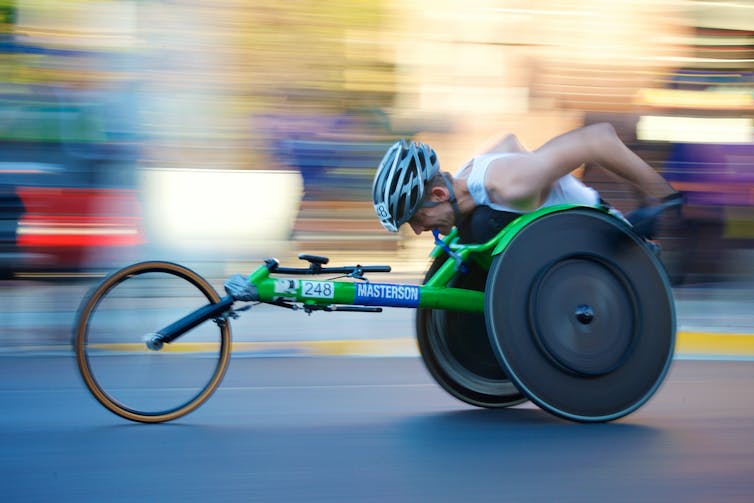COVID-19 has isolated people with disabilities from family, love, sex

Many people with disabilities are facing difficulties maintaining and forming intimate relationships during COVID-19. (Shutterstock)
BY Alan Santinele Martino, McMaster University; Ann Fudge Schormans, McMaster University, and Margaret Campbell, St. Thomas University (Canada)
August 7, 2020
For the millions of people with disabilities living in Canada, COVID-19 containment measures have posed unique challenges to their health and well-being.
Those challenges have included increased social isolation, loss of personal support workers, disruption of vital health services and difficulties accessing basic necessities and information. Many disabled people are also facing difficulties maintaining and forming intimate relationships during COVID-19.
It’s been well-documented that people with disabilities encounter more complex barriers and constraints to exercising their rights to “intimate citizenship,” which refers to our rights to access family, friends, sex and sexuality, and to parent. These rights are enshrined in the United Nations’ Convention on the Rights of Persons with Disabilities, which Canada signed and ratified.
We are just starting to understand how the pandemic has intensified these barriers.
Even before the pandemic, a significant number of disabled people reported feeling socially isolated and lonely. Social isolation has a number of negative repercussions, including poor mental and physical health. The isolation and loneliness that many people with disabilities typically experience has been exacerbated by responses to the COVID-19 pandemic.
Activities put on hold
For example, due to social distancing measures, many of the programs, activities and spaces that people with disabilities make use of have been temporarily suspended.

Unfortunately, some people with disabilities are only able to see their romantic partners at these organized activities. Similarly, some may need staff support, people who will help them pursue social, romantic and sexual activities, and these supports have been scaled back to the basics. For example, staff may support disabled people in navigating dating apps, staying in touch with romantic partners and participating in community events where they can meet people.
Even during normal times, accessible spaces where people with disabilities can form intimate relationships are extremely limited. These limited spaces and opportunities are related to ableist beliefs that people with disabilities are undesirable and not interested in or capable of having romantic and sexual lives. These beliefs deny disabled peoples’ agency.
Even when recognized, sexuality is often seen as a luxury, rather than a right. In general, disability and sexuality remains a taboo — constrained, policed, prohibited. Consequently, this important aspect of social life has been overlooked during the pandemic.
Connecting with partners almost impossible
For those who are involved in institutionalized care arrangements, they may find that their time and daily routines are even more restricted than before. Opportunities to connect with family, friends and romantic/sexual partners are very difficult to secure.

Visitation bans and lack of contact with family members have cut people with disabilities off from their support systems and people familiar with their needs.
Families of people with disabilities have also been at a loss in terms of access to information, guidance and services related to fast-changing circumstances brought by COVID-19.
There is a history of forced institutionalization in Canada. For people with disabilities who have experienced institutionalization, who lack access to the communities where they live, who are unable to visit with family, friends or romantic and sexual partners, the recent separation from community life can take on a different meaning. Amid COVID-19, unfortunately, institutionalized care can look a lot like institutionalization.
Many people with disabilities living in their own homes or with family members, on the other hand, require support from others in their daily lives. Having support persons in their home may, however, increase their vulnerability to COVID-19.

At the same time, if direct care workers are unable or unwilling to come into work, people with disabilities may not have access to necessary supports, including personal care, food access, parenting support or support for virtual social connection.
Gender-based violence
The pandemic has also raised serious concerns around gender-based violence. Prior to the pandemic, disabled women, disabled trans women and woman-identifying disabled sex workers already experienced higher rates of forms of abuse and violence when compared to non-disabled women. COVID-19 has increased these risks significantly.
The isolation that people with disabilities are experiencing may also be worsened by the fact that some, if not many, individuals lack access to technology like computers, the internet and cellphones. These technologies would allow them to remain connected with others.
Some people may require support or training to use these technologies, support and training that’s no longer available. Others may not be “allowed” to use those technologies in their care homes. People with disabilities are commonly infantilized (particularly people with intellectual disabilities) and viewed as incapable of navigating important technological resources.
Left behind
People with disabilities are being left behind in our response to COVID-19. This is evident in the meagre benefit that was initially offered to disabled people by the federal government and in the myriad ways planning has not included them.
Importantly, within the larger and diverse disability community, some experience greater risk and disadvantage than others. Self-advocates with intellectual disabilities from People First Canada have shared how it feels to be “the left behind of the left behind.”
Equality, inclusion and love are for everyone! #Pride #Inclusion pic.twitter.com/46DT04RhCP
— People First Canada (@PeopleFirstCA) June 24, 2020
It is essential that when addressing the current pandemic that no one is forgotten in our response.
Considerations with respect to disability, age, sexuality, gender, race, class, citizenship and social status must be taken into account.![]()
Alan Santinele Martino is a PhD Candidate in sociology at McMaster University; Ann Fudge Schormans is an associate professor of social work at McMaster University; and Margaret Campbell is an adjunct assistant professor of Sociology at St. Thomas University (Canada). This article is republished from The Conversation under a Creative Commons license. Read the original article.


